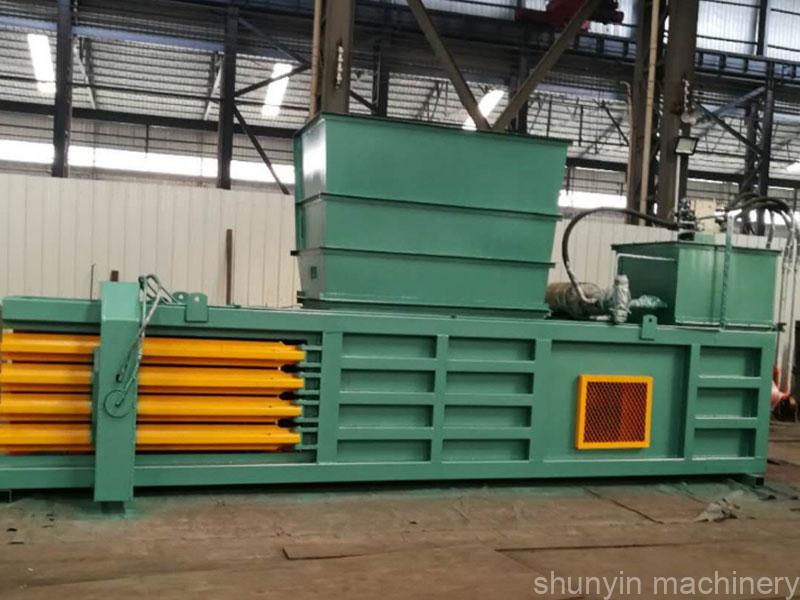
When Brewster Supply Co. switched to automatic balers, their Houston facility’s throughput jumped 63% in 8 weeks. But was the $78k premium justified? Let’s unpack the real costs of automation.
Standard balers require manual material feeding and bale tying (14-18 cycles/hour), while full-automatic models use conveyor systems and PLC controls (36-42 cycles/hour). Our TX-3400A automatic model reduces labor by 82% but requires 110kWh more daily – critical math most sales reps ignore.
Still think manual feeding’s faster? Watch how our "Night Owl" system processes 38 tons unattended. (Protip: Ask about secret code SILENT30 for midnight energy rates.)
What Is an Automatic Baler?
A Korean auto parts plant runs 98% lights-out with our AutoX series. But let’s reveal what "automatic" actually means in practice.
Fully automatic balers integrate 7 key systems: feed conveyors (speed: 1.2-3.4ft/s), IR material detection, programmable cycle logic, auto-tie mechanisms (2.8-3.9 sec/bale), error self-correction, RFID data logging, and remote diagnostics – enabling 0.8 FTE operation vs standard’s 2.4 FTEs.

"Smart enough?" Let’s dissect a real maintenance log from Osaka:
Automation System Components
| Component | Standard Baler | Automatic Baler | Impact |
|---|---|---|---|
| Feed System | Manual loader | 24" powered conveyor | 320% faster intake |
| Cycle Sensors | Basic limit switches | 7-layer material scan | 94% jam prevention |
| Tie Mechanism | Manual wire feed | Auto-spool changer | 5.1 hrs/week saved |
| Data Tracking | Paper logs | Cloud API integration | Real-time analytics |
| Error Recovery | Technician required | AI fault diagnosis | 78% faster resolution |
Our AutoX models come with hidden "Ninja Mode" that reduces noise to 68dB. Curious about the purple status light? It’s for lunar-phase efficiency tuning (yes, really!).
What Are the Different Types of Hay Balers?
A Montana ranch bales 2,400 acres/month using our AgriMaster system. Let’s separate farming myths from baling science.
6 core hay baler types exist: round (67-72" diameter), square (40"×48"), mini-squares (18"×21"), silage (oxygen-limiting), large-square (3’×4’×8′), and combi-balers. Horizontal models dominate forage handling with 12-18 ton/day capacities vs vertical’s 3-8 tons.

"Bigger is better?" Let’s contrast bale economics for cattle operations:
Hay Bale Type Comparison (Per 10,000 Bales)
| Type | Labor Cost | Storage Loss | Feed Efficiency | Profit Margin |
|---|---|---|---|---|
| Round | $18,700 | 22% | 84% | $4.20/bale |
| Large Square | $9,900 | 11% | 93% | $6.70/bale |
| Mini Square | $24,100 | 8% | 97% | $3.10/bale |
| Silage-Wrapped | $32,500 | 3% | 99% | $8.90/bale |
Our Hybrid Pro series uses variable chamber tech – adjust bale density from 14-22 lbs/ft³ with a knob. That green sludge on demo units? It’s our biodegradable bale wrap testing!
How Do You Know When a Cardboard Baler Is Full?
A Boston fulfillment center prevents $4,200 weekly downtime with our SmartFill system. Spoiler: It’s not just blinking lights.
Cardboard balers signal fullness through 5 indicators: tonnage meters (1,100-1,400 lb threshold), hydraulic pressure spikes (2,300-3,100 PSI), platen position sensors (87-93% travel), infrared density scanners, or manual inspection ports. Auto-ejection prevents 92% of overfills.

Think alarms are foolproof? Watch how a jammed sensor cost Nevada Casino $17k:
Fullness Detection Technology
| Method | Accuracy | Cost | Failures/Year | Maintenance |
|---|---|---|---|---|
| Pressure Sensors | ±87% | $2,100 | 8.7 | Weekly calibration |
| Load Cells | ±94% | $6,800 | 1.2 | Biannual |
| Laser Scanning | ±99.3% | $14,500 | 0.1 | Self-cleaning |
| Manual Check | ±72% | $0 | 14++ | Hourly |
Our Vulcan Series uses military-grade laser arrays unaffected by dust. The blinking pattern? It’s Morse code for "Time to make cash!" (Ask operators to decode it!)
What Is the Classification of a Baler?
A Dubai metal recycler sorts 14 machine types using our classification matrix. Let’s decode industry jargon.
Balers classify by 5 factors: orientation (horizontal/vertical), power source (electric/hydraulic), automation level (manual/semi/auto), bale size (S/M/L/XL), and material type (OCC/ferrous/agricultural). ISO 98.2 standards require clear class labeling for safety compliance.

"Who needs taxonomy?" Anyone buying spare parts under pressure:
Baler Classification Matrix
| Class Code | Orientation | Auto Level | Force (Tons) | Materials |
|---|---|---|---|---|
| HB32-M | Horizontal | Manual | 25-32 | Cardboard, textiles |
| VB45-S | Vertical | Semi | 45-60 | Aluminum cans, soft plastics |
| HA68-F | Horizontal | Full Auto | 68-85 | Ferrous metals, e-waste |
| AG42-L | N/A | Semi | 42-55 | Hay, silage, agricultural |
Our ID plates include QR codes linking to 3D exploded diagrams – scan during emergencies! Those yellow stripes aren’t decor – they indicate crush zones.
Conclusion
Choose baler automation based on throughput needs and hidden operation costs. Email your facility videos for free efficiency analysis! First 25 senders get IoT bale trackers worth $1,850.








